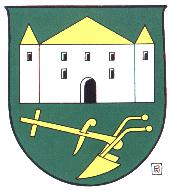Maishofen: Difference between revisions
Jump to navigation
Jump to search
Knorrepoes (talk | contribs) m (Text replace - "Österreich" />" />" to "Österreich" />") |
Knorrepoes (talk | contribs) m (Text replace - "[[Literature" to "{{media}} [[Literature") |
||
| Line 16: | Line 16: | ||
The castle is a symbol for the four castles in the municipality, the Saalhof, Prielau, Kammer and Stiegerschlössl castles. The plough is taken as a canting symbol for Mais. Mais means cleared forest used for agriculture. The name, however, is derived from the personal name Megin. | The castle is a symbol for the four castles in the municipality, the Saalhof, Prielau, Kammer and Stiegerschlössl castles. The plough is taken as a canting symbol for Mais. Mais means cleared forest used for agriculture. The name, however, is derived from the personal name Megin. | ||
{{media}} | |||
[[Literature]] : Zaisberger, F. and Pfeiffer, N. : Salzburger Gemeindewappen. Winter Verlag, Salzburg, 1985 | [[Literature]] : Zaisberger, F. and Pfeiffer, N. : Salzburger Gemeindewappen. Winter Verlag, Salzburg, 1985 | ||
Revision as of 01:18, 9 July 2014
| Heraldry of the World Civic heraldry of Austria - Österreichische Gemeindewappen |
MAISHOFEN
State : Salzburg
District : Zell am See
Origin/meaning
The arms were officially granted on January 23, 1978.
The castle is a symbol for the four castles in the municipality, the Saalhof, Prielau, Kammer and Stiegerschlössl castles. The plough is taken as a canting symbol for Mais. Mais means cleared forest used for agriculture. The name, however, is derived from the personal name Megin.
Contact and Support
Partners:
Your logo here ?
Contact us
© since 1995, Heraldry of the World, Ralf Hartemink 
Index of the site
Literature : Zaisberger, F. and Pfeiffer, N. : Salzburger Gemeindewappen. Winter Verlag, Salzburg, 1985











